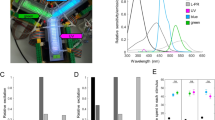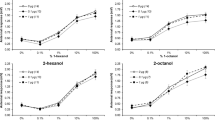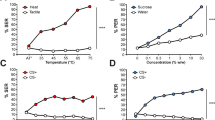Abstract
Insects process and learn information flexibly to adapt to their environment. The honeybee Apis mellifera constitutes a traditional model for studying learning and memory at behavioural, cellular and molecular levels1. Earlier studies focused on elementary associative and non-associative forms of learning determined by either olfactory conditioning of the proboscis extension reflex1 or the learning of visual stimuli2 in an operant context. However, research has indicated that bees are capable of cognitive performances that were thought to occur only in some vertebrate species. For example, honeybees can interpolate visual information3, exhibit associative recall4,5, categorize visual information6,7,8 and learn contextual information9. Here we show that honeybees can form ‘sameness’ and ‘difference’ concepts. They learn to solve ‘delayed matching-to-sample’ tasks, in which they are required to respond to a matching stimulus, and ‘delayed non-matching-to-sample’ tasks, in which they are required to respond to a different stimulus; they can also transfer the learned rules to new stimuli of the same or a different sensory modality. Thus, not only can bees learn specific objects and their physical parameters, but they can also master abstract inter-relationships, such as sameness and difference.
This is a preview of subscription content, access via your institution
Access options
Subscribe to this journal
Receive 51 print issues and online access
$199.00 per year
only $3.90 per issue
Buy this article
- Purchase on Springer Link
- Instant access to full article PDF
Prices may be subject to local taxes which are calculated during checkout



Similar content being viewed by others
References
Menzel, R. & Müller, U. Learning and memory in honeybees: from behavior to neural substrates. Annu. Rev. Neurosci. 19, 379–404 (1996).
Menzel, R. in Experimental Behavioral Ecology (eds Hölldobler, B. & Lindauer, M.) 55–74 (Gustav Fischer, Stuttgart, 1985).
Collett, T. S. & Baron, J. Learnt sensori-motor mappings in honeybees: interpolation and its possible relevance to navigation. J. Comp. Physiol. A 177, 287–298 (1995).
Srinivasan, M. V., Zhang, S. W. & Zhu, H. Honeybees links sights to smells. Nature 396, 637–638 (1998).
Zhang, S. W., Lehrer, M. & Srinivasan, M. V. Honeybee memory: navigation by associative grouping and recall of visual stimuli. Neurobiol. Learn. Mem. 72, 180–201 (1999).
Hateren, J. H., Srinivasan, M. V. & Wait, P. B. Pattern recognition in bees: orientation discrimination. J. Comp. Physiol. A 167, 649–654 (1990).
Giurfa, M., Eichmann, B. & Menzel, R. Symmetry perception in an insect. Nature 382, 458–461 (1996).
Horridge, G. A. & Zhang, S. W. Pattern vision in honeybees (Apis mellifera): flower-like patterns with no predominant orientation. J. Insect Physiol. 41, 681–688 (1994).
Collett, T. S., Fauria, K., Dale, K. & Baron, J. Places and patterns—a study of context learning in honeybees. J. Comp. Physiol. A 181, 343–353 (1997).
Moon, L. E. & Harlow, H. F. Analysis of oddity learning by rhesus monkeys. J. Comp. Physiol. Psychol. 48, 188–194 (1955).
Strong, P. N. & Hedges, M. Comparative studies in simple oddity learning. 1. Cats, racoons, monkeys and chimpanzees. Psychonom. Sci. 5, 13–14 (1966).
Thomas, R. K. & Boyd, M. G. A comparison of Cebus albifrons and Samiri sciureus on oddity performance. Anim. Learn. Behav. 1, 151–153 (1973).
Herman, L. M. & Gordon, J. A. Auditory delayed matching in the bottlenose dolphin. J. Exp. Anal. Behav. 21, 19–26 (1974).
Zentall, T. R. & Hogan, D. E. Same/different concept learning in the pigeon: the effect of negative instances and prior adaptation to transfer stimuli. J. Exp. Anal. Behav. 30, 177–186 (1978).
Holmes, P. W. Transfer of matching performance in pigeons. J. Exp. Anal. Behav. 31, 103–114 (1979).
Lombardi, C. M., Fachinelli, C. G. & Delius, J. D. Oddity of visual patterns conceptualized by pigeons. Anim. Learn. Behav. 12, 2–6 (1984).
D'Amato, M. R., Salmon, D. P. & Colombo, M. Extent and limits of the matching concept in monkeys (Cebus apella). J. Exp. Psychol. Anim. Behav. Proc. 11, 35–51 (1985).
Wilson, B., Mackintosh, N. J. & Boakes, R. A. Transfer of relational rules in matching and oddity learning by pigeons and corvids. Quart. J. Exp. Psychol. 37B, 313–332 (1985).
Oden, D. L., Premack, D. & Thompson, R. K. R. Spontaneous transfer of matching by infant chimpanzees. J. Exp. Psychol. Anim. Behav. Proc. 14, 140–145 (1988).
Wright, A. A., Santiago, H. C., Urcuioli, P. J. & Sands, S. F. in Quantitative Analyses Of Behavior: Discrimination Processes Vol. IV (eds Commons, M. L., Herrnstein, R. J. & Wagner, A. R.) 295–317 (Ballinger, Cambridge MA, 1984).
Davey, G. Ecological Learning Theory (Routledge, London, 1989).
Menzel, R. & Giurfa, M. Cognitive architecture of a mini-brain: the honeybee. Trends Cognit. Sci. 5, 62–71 (2001).
Hammer, M. The neural basis of associative reward learning in honeybees. Trends Neurosci. 20, 245–252 (1997).
Acknowledgements
We thank C. Bönisch and C. Wiley for help with experiments 5 and 6. M.G., A.J. and R.M. were supported by the Special Programme SFB 515 of the Deutsche Forschungsgemeinschaft. M.G. was also supported by a grant from the Deutsche Forschungsgemeinschaft. S.W.Z. and M.S. were supported partly by a grant from the Human Frontiers in Science Program and from the US Defence Advanced Research Projects Agency and the Office of Naval Research. The two laboratories contributed equally to the work.
Author information
Authors and Affiliations
Corresponding author
Rights and permissions
About this article
Cite this article
Giurfa, M., Zhang, S., Jenett, A. et al. The concepts of ‘sameness’ and ‘difference’ in an insect. Nature 410, 930–933 (2001). https://doi.org/10.1038/35073582
Received:
Accepted:
Issue Date:
DOI: https://doi.org/10.1038/35073582
This article is cited by
-
Rodent maze studies: from following simple rules to complex map learning
Brain Structure and Function (2024)
-
Relational reasoning in wild bumblebees revisited: the role of distance
Scientific Reports (2023)
-
Navigation and dance communication in honeybees: a cognitive perspective
Journal of Comparative Physiology A (2023)
-
A Behavioral Approach to the Human Understanding of Time: Relational Frame Theory and Temporal Relational Framing
The Psychological Record (2023)
-
Geometry-based navigation in the dark: layout symmetry facilitates spatial learning in the house cricket, Acheta domesticus, in the absence of visual cues
Animal Cognition (2023)
Comments
By submitting a comment you agree to abide by our Terms and Community Guidelines. If you find something abusive or that does not comply with our terms or guidelines please flag it as inappropriate.



